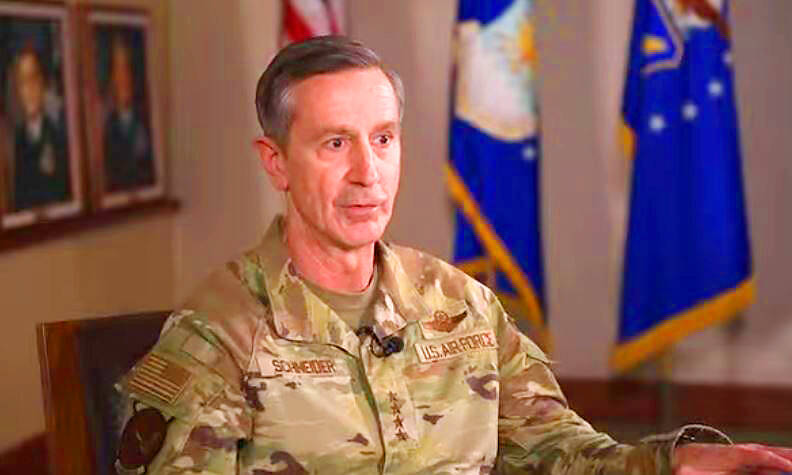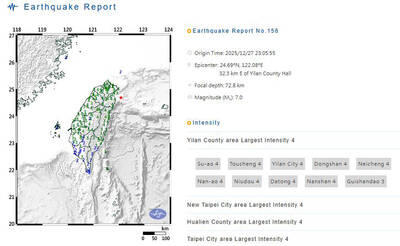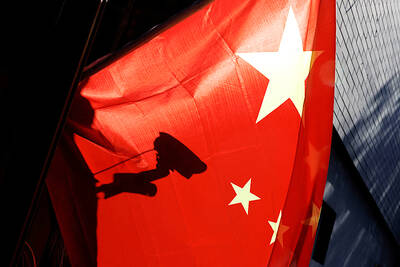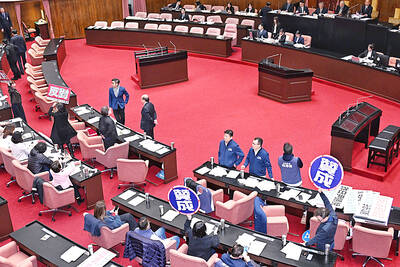China has increased its provocative incursions around Taiwan by 300 percent since May, US Commander of Pacific Air Forces General Kevin Schneider said in an interview published yesterday, adding that adversaries in the region could try to test the new administration of US president-elect Donald Trump.
“Whether it’s coming into the air defense identification zone [ADIZ] or crossing the center line within the Taiwan Strait, since the inauguration [of president William Lai (賴清德)], we have seen a 300 percent increase in those air activities,” Schneider told NBC News.
From May to November last year, Chinese aircraft intruded into Taiwan’s ADIZ 335 times, Ministry of National Defense data showed.

Photo: screen grab from the US Pacific Air Force Facebook page
In the same time frame this year, China intruded into that same airspace at least 1,085 times, more than three times as many as the previous year, NBC News reported.
The difference was more pronounced in the summer — 50 Chinese aircraft entered Taiwan’s ADIZ in July last year, while 210 entered it in July this year, more than four times as many, it said.
The Chinese People’s Liberation Army (PLA) Air Force has maintained the increased activity level since Lai was sworn in on May 20, Schneider said.
Liu Pengyu (劉鵬宇), a spokesman for the Chinese embassy in Washington, was quoted by NBC News as saying that the flights are fully consistent with international law and common practices, adding that “the PLA’s relevant drills are a necessary and legitimate move to crack down on ‘Taiwan independence’ separatist forces.”
Schneider said the biggest challenge he faces comes from Beijing, which is building a massive rocket force, air force, submarine force and cyberforce, which it uses to intimidate other nations in the region.
“It’s the behaviors that have gone along with that. It’s the bullying, the aggressiveness,” Schneider said.
“My assessment is it’s a pressurization campaign designed to win without fighting, and I think just to continue to impose costs, physical or otherwise, to present a fait accompli to the world,” he said. “Not just to Taiwan, but to the world that Beijing can accomplish their objectives, and they continue to ramp up their activities, military activities, in conjunction with diplomatic activities, informational activities, economic activities, to win without fighting.”
US intelligence officials have said that 2027 could be an inflection point for a cross-strait conflict, which would come during Trump’s second term in office, but the returning president has not committed to defending Taiwan during a Chinese invasion, NBC News reported.
It quoted Schneider as saying that 2027 as the year for possible action by Beijing is still uncertain, but added that China’s behavior has grown more aggressive and it is operating farther away from China.
Learning from how the US has operated in the Middle East, Beijing aims to push the US out of the region, while bolstering its military capabilities, the general said.
“We had the ability to take our time, to bring our forces into the theater, to build up large bases, to build up our capability and then at the time of our choosing, when we had the advantages of mass in place, were able to determine when we would go to conduct our operations,” he said. “I assess that Beijing has recognized that, and now they are building this capability to prevent us from ever being able to do that and replicating it.”
Adversaries in the region could try to test the new Trump administration in its early days, and opportunist “actors in the region may seek to challenge a new administration,” he said.
“It’s something that we on the military side are ready for, and we continue to provide options back to our national leadership,” he said.
Ultimately, the US is still focused on effective deterrence to prevent conflict in the region, Schneider said.
“And if that peace, stability and security is unilaterally upended by anyone in the region, then we will react, and we will react with a network of allies and partners that is incredibly capable,” he added.

A magnitude 7.0 earthquake struck off Yilan at 11:05pm yesterday, the Central Weather Administration (CWA) said. The epicenter was located at sea, about 32.3km east of Yilan County Hall, at a depth of 72.8km, CWA data showed There were no immediate reports of damage. The intensity of the quake, which gauges the actual effect of a seismic event, measured 4 in Yilan County area on Taiwan’s seven-tier intensity scale, the data showed. It measured 4 in other parts of eastern, northern and central Taiwan as well as Tainan, and 3 in Kaohsiung and Pingtung County, and 2 in Lienchiang and Penghu counties and 1

A car bomb killed a senior Russian general in southern Moscow yesterday morning, the latest high-profile army figure to be blown up in a blast that came just hours after Russian and Ukrainian delegates held separate talks in Miami on a plan to end the war. Kyiv has not commented on the incident, but Russian investigators said they were probing whether the blast was “linked” to “Ukrainian special forces.” The attack was similar to other assassinations of generals and pro-war figures that have either been claimed, or are widely believed to have been orchestrated, by Ukraine. Russian Lieutenant General Fanil Sarvarov, 56, head

FOREIGN INTERFERENCE: Beijing would likely intensify public opinion warfare in next year’s local elections to prevent Lai from getting re-elected, the ‘Yomiuri Shimbun’ said Internal documents from a Chinese artificial intelligence (AI) company indicated that China has been using the technology to intervene in foreign elections, including propaganda targeting Taiwan’s local elections next year and presidential elections in 2028, a Japanese newspaper reported yesterday. The Institute of National Security of Vanderbilt University obtained nearly 400 pages of documents from GoLaxy, a company with ties to the Chinese government, and found evidence that it had apparently deployed sophisticated, AI-driven propaganda campaigns in Hong Kong and Taiwan to shape public opinion, the Yomiuri Shimbun reported. GoLaxy provides insights, situation analysis and public opinion-shaping technology by conducting network surveillance

‘POLITICAL GAME’: DPP lawmakers said the motion would not meet the legislative threshold needed, and accused the KMT and the TPP of trivializing the Constitution The Legislative Yuan yesterday approved a motion to initiate impeachment proceedings against President William Lai (賴清德), saying he had undermined Taiwan’s constitutional order and democracy. The motion was approved 61-50 by lawmakers from the main opposition Chinese Nationalist Party (KMT) and the smaller Taiwan People’s Party (TPP), who together hold a legislative majority. Under the motion, a roll call vote for impeachment would be held on May 19 next year, after various hearings are held and Lai is given the chance to defend himself. The move came after Lai on Monday last week did not promulgate an amendment passed by the legislature that